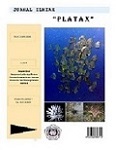Seagrass Community Structure at Ratatotok Beach, Southeast Minahasa Regency
DOI:
https://doi.org/10.35800/jip.v11i2.47824Keywords:
Seagrass;, community structure; , Ratatotok beach;Abstract
The purpose of this research is to know about the type of seagrass, the community structure of seagrass based on the density of type, the density of the relatively, type of frequency, frequency relatively, type of cover, cover relatively, diversity index, dominance and parameter index in surrounding water environment of seagrass at Ratatotok beach. The result of this research is identifying 4 species, namely; Thalassia hemprichii, Enhalus acoroides, Syringodium isoetifolium dan Halodule pinifolia. The value of density is 39 indv/m2, the value type of frequency is 7.9, the value type of cover is 39.15, importance value index had 159.04%. Thalassia hemprichii, diversity index is “medium” with an average value (H’) of 2.63 and a higher importance index with an average value of C of 0.82. Surrounding waters at Ratototok Beach got a “medium” value of seagrass cover value is 39%. Environmental parameters in surrounding waters at Ratatotok beach had a value within; Temperature 31.95 0C, salinity 29.79o/oo, pH 7.62, DO 5.60 mg/L and the type of substrate found is sandy, sandy mud and coral fragments.
Keywords: Seagrass, Community structure, Ratatotok beach.
Abstrak
Tujuan dilakukan penelitian ini yaitu mengetahui jenis lamun, struktur komuntas lamun berdasarkan kepadatan jenis, kepadatan relatif, frekuensi jenis, frekuensi relatif, penutupan jenis, penutupan relatif, indeks keanekaragaman, indeks dominansi dan parameter lingkungan perairan padang lamun yang berada di sekitar Pantai Ratatotok. Hasil yang di peroleh dari penelitian ini teridentifikasi 4 spesies, yaitu: Thalassia hemprichii, Enhalus acoroides, Syringodium isoetifolium dan Halodule pinifolia. Dengan nilai kepadatan 39 ind/m2, frekuensi jenis 7,9, penutupan jenis 39,15, Indeks nilai penting (INP) diperoleh nilai 159,04 %, pada Thalassia hemprichii, Indeks keanekaragaman “sedang” dengan nilai rata-rata (H’) 2,63 dan indeks dominansi tinggi dengan nilai rata-rata C 0,82. Berdasarkan kategori penutupan lamun yang terdapat di sekitar Perairan Ratatotok dikategorikan “sedang” dengan nilai penutupan 39%. Parameter lingkungan antara lain: suhu 31,95 0C, salinitas 29,79 o/oo, pH 7,62, DO 5,60 mg/l dan jenis substrat yang di temukan adalah berpasir, pasir berlumpur dan pecahan karang.
Kata kunci : Lamun, Struktur Komunitas, Pantai Ratatotok
References
Bortone, S.A. 2000. Seagrasses: monitoring, ecology, physiology and management. CRC Press. Boca Raton, Florida. 318p.
Dahuri, R., Jacub R., Sapta, P. G., dan Sitepu, M. J. 2001. Pengelolaan Sumberdaya Wilayah Pesisir dan Lautan Terpadu. Jakarta: PT Pradnya Paramita.
Dahuri, R., 2003. Keanekaragaman Hayati Laut Aset Pembangunan Berkelanjutan Indonesia. Gramedia Pustaka Utama: Jakarta.
den Hartog, C. & J. Kuo. 2006. Taxonomy and biogeography of seagrasses. Dalam : Larkum, A.W.D., R.J. Orth, & C.M. Duarte (eds), Seagrasses: Biology, Ecology and Conservation. Springer. Netherlands. 1-23.
Fachrul, M. F. (2007). Metode Sampling Bioekologi. Jakarta: Bumi Aksara.
Fahruddin, M. F., Yulianda, Setyobudiandi, I. 2017. Kerapatan dan Penutupan Ekosistem Lamun di Pesisir Desa Bahoi, Sulawesi Utara. Jurnal Ilmu dan Teknologi Kelautan Tropis, 9(1): 375 – 383.
Hernawan, U. E., Nurul, D. M. S., Indarto, H. S., Suyarso, Marindah, Y. I., Kasih, A., & Rahmat. 2017. Status Padang Lamun Indonesia 2017. Puslit Oseanografi - LIPI. Jakarta
Insafitri, I. 2010. Keanekaragaman, Keseragaman dan Dominansi Bivalvia di Area Buangan Lumpur Lapindo Muara Sungai Porong. Jurnal KELAUTAN, 3(1): 54 – 59.
Madduppa, H. H. 2016. Modul Pelatihan: Teknik Analisis Kuantitatif Data Biologi Laut. Bogor: Institut Pertanian Bogor.
McKenzie, L.J., Campbell, S.J. and Roder, C.A. 2003. Seagrass-Watch: Manual for Mapping & Monitoring Seagrass Resources by Community (citizen) volunteers. 2nd Edition. (QFS, NFC, Cairns) 100pp.
Nusi S. R. A. R, Abdul H. O, & Syamsudin. 2013. Struktur vegetasi lamun di perairan pulau saronde, Kecamatan ponelo kepulauan, Kabupaten Gorontalo utara. Jurusan Teknologi Perikanan, Fakultas Ilmu Pertanian, Universitas Negeri Gorontalo.
Poedjirahajoe E, Mahayani NPD, Sidharta BR, Salamuddin M. 2013. Tutupan Lamun dan Kondisi Ekosistemnya di Kawasan Pesisir Madasanger, Jelenga, dan Maluk Kabupaten Sumbawa Barat. Jurnal Ilmu dan Teknologi Kelautan Tropis, 5 (1): 36–46.
Poiner, I. R., D. I. Walker, & Coles R.G. 1989. Regional Studies-Seagrass of Tropical Australia. In Biology of Seagrass: A Treatise on the Biology of Seagrass with Special Reference to the Australian Region. (Eds A.W.D. Larkum, A.J. McComb and S.A. Sheperd) Chapter 10, pp. 279-296 Elsevier: New York.
Rahmawati, S., Irawan, A., Supriyadi I. H., & Azkab M. H. 2017. Panduan Pemantauan Penilaian Kondisi Padang Lamun. Edisi 2. Jakarta: COREMAP CTI LIPI. vi + 35 hlm.
Rugebregt, M. J. 2015. Ekosistem Lamun di Kawasan Pesisir Kecamatan Kei Besar Selatan, Kabupaten Maluku Tenggara, Provinsi Maluku, Indonesia. Jurnal Widyariset. Vol. 1(1):79-86.
Sjafrie, N. D., Hernawan, U. E., Prayudha, B., Supriyadi, I. H., Iswari, M. Y., Rahmat, Anggraini, K., Rahmawati, S., Suyarso. 2018. Status Padang Lamun di Indonesia Ver.02. Jakarta: Puslit Oseanografi-LIPI, 37 Hal.
Suhud. M.A., Pratomo. A., & Yandri. F. (2012). Struktur Komunitas Lamun di Perairan Pulau Nikoi. Jurnal Ilmiah Universitas Maritim Raja Ali Haji.
Tuwo, A. 2011. Pengelolaan Ekowisata pesisir dan Laut. Sidoarjo: Brilian Internasional.
Yunitha, A., Wardianto, Y.& Yulianda, F. 2014. Diameter Substrat dan Jenis Lamun di Pesisir Bahoi Minahasa Utara: Sebuah Analisis Korelasi. Jurnal Ilmu Pertanian Indonesia. 19(3):130-135
Downloads
Published
How to Cite
Issue
Section
License
Copyright (c) 2023 Dhebby Purba, Billy Wagey, Alfret Luasunaung, Indri Manembu, Deiske Sumilat, Rose Mantiri

This work is licensed under a Creative Commons Attribution-NonCommercial 4.0 International License.
COPYRIGHT
Authors who publish with this journal agree to the following terms:
Authors hold their copyright and grant this journal the privilege of first publication, with the work simultaneously licensed under a Creative Commons Attribution License that permits others to impart the work with an acknowledgment of the work's origin and initial publication by this journal.
Authors can enter into separate or additional contractual arrangements for the non-exclusive distribution of the journal's published version of the work (for example, post it to an institutional repository or publish it in a book), with an acknowledgment of its underlying publication in this journal.
Authors are permitted and encouraged to post their work online (for example, in institutional repositories or on their website) as it can lead to productive exchanges, as well as earlier and greater citation of the published work (See The Effect of Open Access).






































